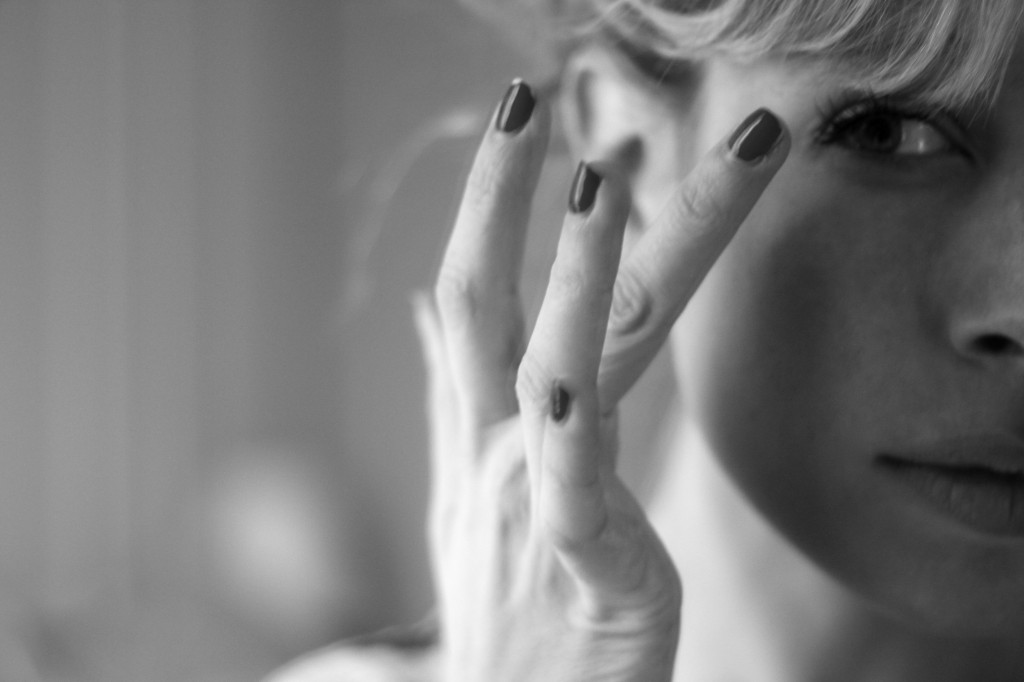
UPDATE: I wrote a post about a new solution I tried; check it out here.
Q. I noticed your eyes are two different sizes. Mine are the same, so I rarely wear eye makeup as I don’t want to draw more attention to the size difference. Are there any tips you have to play this down?
A. You noticed correctly! I first realized that my eyes were two different sizes when I was thirteen and started doing a little modeling work (that’s my first headshot, above), and a photographer was all, “WHOA. You need to not smile like that.” And he taught me how to smile for photos so that one eye didn’t scrinch up into nothingness. And I did that for awhile, but then later abandoned my efforts when I realized that it was kind of weird to overthink an expression of happiness that’s theoretically supposed to be…you know…genuine.
Read the (real) story behind It’s Always Sunny In Philadelphia here (spoiler: I’m Sweet Dee)
What you’re talking about – that kind of asymmetry where one eye appears larger than the other – is very common to different degrees, and actually usually not caused by a difference in eye size, but rather by a difference in how much the lid covers each eye.
From the Washington Post:
Andrew Prince, a Manhattan ophthalmologist, says he frequently sees patients with one eye that at least appears larger than the other.
“Often it’s an illusion,” Prince explains, that occurs “when the lid, more often the upper lid, is drooping. The asymmetric appearance can make patients think ‘My eye is shrinking’ or ‘My eye is bulging.'”
Uneven eye size can be congenital — something you’re born with — or it can be related to surgery, injury or certain eye diseases, Prince says. “The most common cause is age,” he adds, noting that eyelid drooping (ptosis) often happens as we grow older.
My asymmetry, for example, is congenital…but then was exacerbated by The Great Cocktail Straw Incident Of 2010 (it’s gross; go ahead and read the post if you’re interested); the incident resulted in chronic corneal erosion and swelling that gets worse when I’m tired or dehydrated.
It’s no fun, mostly because it’s a) uncomfortable and b) part of my job involves taking bajagillions of photos and videos of…my face.
Assuming you’re not experiencing discomfort, though, here’s the thing: everyone has aspects of their appearance that they’re not thrilled with. Everyone is asymmetrical to some extent. And sure, perceived “flaws” can make us feel uncomfortable, or self-conscious…but they’re also just par for the course, and a big part of what make you all those wonderful and weird things that you are.
Read about my experiences with sexual assault and self-esteem.
OPTIONS FOR YOU:
That said, if you still want to find ways to minimize the appearance of asymmetry (which I certainly try to do – with variable success – during photo shoots, so I hear you), there are a bunch of options you can call into action.
- Surgical Intervention. This is not something that I would do unless you’re talking about an issue that seriously impacts your life or livelihood. I’m not entirely sure what the options (or the costs) are, but some Googling has led me to believe that it could involve having an oculoplastic surgeon remove excess skin/fat deposits. Or a simple shot of Botox, depending on the particular issue you’re having.
- Hydration. If you notice that your eyes seem to appear more asymmetrical when you’re tired or dehydrated, it might be a swelling issue. If you have an important event coming up, try to pay extra attention to getting rest and drinking plenty of water.
3. Makeup! I know you said that you don’t like to wear lots of makeup to draw more attention to your eyes, but what I’ve found is that the following little tricks help a lot:
- Create the visual illusion of bigger eyes by starting with a base shadow in a pale pink or gold shade. Enhance the effect by lightly smudging a highlighter (I love NARS’ Soft Touch Shadow Pencil in Hollywoodland) into the inner corner of your eye.
- Balance out the shape by using liquid liner to draw a slightly thicker line on the “smaller” eye. (This one is my favorite.)
- Lengthening mascara (and a lash curler) can do wonders to open up the eye, creating a larger effect. I also like applying a half-strip of false lashes to the outer edges to create a dramatic effect that both minimizes asymmetry and draws the eye elsewhere (click here for a how-to).
Finally: I am sure – and I mean this from the bottom of my heart – that the asymmetry that you feel that your eyes have in no way impacts your loveliness. The human body is asymmetrical by nature, and I genuinely think that that’s for a reason: to let us know that differences on the outside are just as OK as differences on the inside, and that when it comes down to it…it’s all good.
Think about it: when you look at someone and notice what is beautiful about them, what you’re seeing is what makes them special, not what makes them “perfect”…and symmetry is nothing if not the replacement of what is extraordinary with what is regular.



